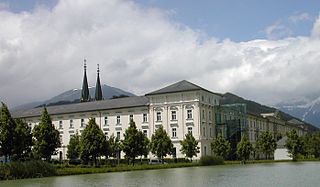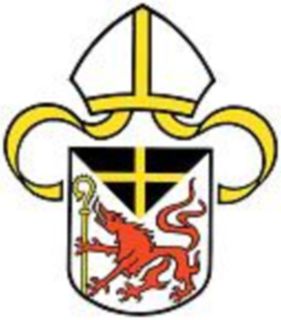 |
The St. Nikola Abbey is a former monastery [1] [2] [3] of the Augustinian canons and today's mother house of the German Oratory Sisters in Passau, Lower Bavaria, Germany. [4]
 |
The St. Nikola Abbey is a former monastery [1] [2] [3] of the Augustinian canons and today's mother house of the German Oratory Sisters in Passau, Lower Bavaria, Germany. [4]
St. Nikola was donated by Altmann, Bishop of Passau, the former Kapellan of the Empress Agnes, around 1070 (30 September 1067 according to the Founding Letter; 3 March 1072 according to the privilege of Pope Alexander II). Soon after the foundation, the monastery became engulfed in the turmoil of investiture, and the canons of the monastery were expelled. In 1111, the penitent appears to be re-established, which is confirmed by a certificate of the possession of Emperor Henry V. By the passage of the Vogteirechte from the Formbacher-Viegernern to the Ortenburger, which were displaced by the dukes of Bavaria, the Passau bishops lost the pin 1248 to the Bavarian dukes. Thus, in contrast to the Princely Passau, the monastic complex was situated in the area of Bavaria.
The monastic life gave rise to criticism in the fifteenth century, as in a visitation by Nicholas Cusanus. In the 16th century, St. Nikola was captured by the Reformation. The prophet Thomas Gunner stepped over to the teaching of Luther, but had to flee to Austria in 1556. It was only in the course of further years that the counter-revolution could take root, as confirmed by the papal Nuncio Ninguarda in 1581, during his visitation. Since the prophet Claudius Aichel (1666–1683) the abbots of the monastery were given the right to bear the miter.
Several parishes were also incorporated into the monastery, namely Bavaria, Aidenbach, Alburg, Hartkirchen, Pocking and Mittich, and also in Austria Alkofen, Grieskirchen, Münichreith, Neukirchen, Wimsbach, Roitham at the Traunfall and Pollham. After the dissolution of the monastery, these became independent parishes, which were mostly cared for by the choir-makers of St. Nikola. The monastery of Sankt Oswald was briefly (1431–1563) supervised by St. Nikola, but then passed to the Benedictines. The last of the Exchorherren, Isidor Alois Reisinger, died on 8 May 1851 in Kirchdorf. The four Freihöfe of the monastery in the Habsburg countries were withdrawn by the Lower Austrian state property administration and later sold. The most important was probably the Nikolaihof in Mautern an der Donau; the former Turmhof in Horn now serves as a town hall, and also the Klosterneuburgger Hof in Klosterneuburg and the Freyhof in Aschach on the Danube.
In the Baroque period, the monastery building had offered a home and workshop to several generations of sculptors. Among them, Joseph Matthias Götz, and Joseph Deutschmann, for the time being the most important workshop of the sculpture system was located between Munich and Vienna.

The Diocese of Passau is a Roman Catholic diocese in Germany that is a suffragan of the Archdiocese of Munich and Freising. Though similar in name to the Prince-Bishopric of Passau—an ecclesiastical principality that existed for centuries until it was secularized in 1803—the two are entirely different entities. The diocese covers an area of 5,442 km².

The Innviertel is a traditional Austrian region southeast of the Inn river. It forms the western part of the state of Upper Austria and borders the German state of Bavaria. The Innviertel is one of the four traditional "quarters" of Upper Austria, the others being Hausruckviertel, Mühlviertel, and Traunviertel.

Kremsmünster Abbey is a Benedictine monastery in Kremsmünster in Upper Austria.

Göttweig Abbey is a Benedictine monastery near Krems in Lower Austria. It was founded in 1083 by Altmann, Bishop of Passau.

Nonnberg Abbey is a Benedictine monastery in Salzburg, Austria. Founded c. 712/715 by Saint Rupert of Salzburg, it is the oldest continuously existing nunnery in the German-speaking world. The monastery complex is today a protected monument and part of the Historic Centre of the City of Salzburg, a UNESCO World Heritage Site since 1996.

Admont Abbey is a Benedictine monastery located on the Enns River in the town of Admont, Austria. The oldest remaining monastery in Styria, Admont Abbey contains the largest monastic library in the world as well as a long-established scientific collection. It is known for its Baroque architecture, art, and manuscripts.

Saint Paul's Abbey in Lavanttal is a Benedictine monastery established in 1091 near the present-day market town of Sankt Paul im Lavanttal in the Austrian state of Carinthia. The premises centered on the Romanesque monastery church were largely rebuilt in a Baroque style in the 17th century.
Innsbruck, an Austrian city, was annexed by Nazi Germany in 1938. It was bombed 22 times by the Allies in World War II, suffering heavy damage.

Markt Indersdorf is a municipality in the district of Dachau in Bavaria in Germany.

Trumau is a town in the district of Baden in Lower Austria in Austria.

Herzogenburg Monastery is an Augustinian monastery located in Herzogenburg in Lower Austria. Founded in 1112 by Augustinian Canons, the monastery was refurbished in the Baroque style in 1714 by Jakob Prandtauer, Johann Bernhard Fischer von Erlach, and Josef Munggenast.

Lauriacum was an important legionary Roman town on the Danube Limes in Austria.

St. George's Abbey is a monastic complex in the village of Sankt Georgen am Längsee, Carinthia, Austria. It celebrated its 1,000th anniversary in 2003.

Reichersberg Abbey is a monastery of the Innviertel Congregation of the Austrian Augustinian Canons. It lies on the Inn River in Reichersberg, Upper Austria.

The Donausteig is a hiking trail that passes through parts of Bavaria and Austria. Since the summer of 2010, the trail follows both banks of the Danube, from Passau via Linz up to St. Nikola and Grein.

Altmann was the Bishop of Passau from 1065 until his death. He was an important representative of the Gregorian reforms, monastic founder and reformer. He is venerated as a saint, but not officially canonised.

Reginbert of Hagenau also called Raimbert was 1130 provost of the Stift St. Pölten and in 1138 bishop of Passau.

Raiffeisenlandesbank Oberösterreich AG is a credit institution and grouping of cooperative banks founded in the 1900s and headquartered in Linz, Austria. It is the central institution of the Raiffeisen Banking Group in Upper Austria and the largest of Austria's eight provincial central banks.
Alois Dorn was an Austrian visual artist known in particular as a sculptor, a painter, a glass-painter and a creator of mosaics.

The Budweis-Linz-Gmunden Horse-Drawn Railway was the second public railway line to be opened in mainland Europe. It opened in stages between 1827 and 1836, and principally served the transport of salt from the Upper Austrian Salzkammergut to Bohemia.